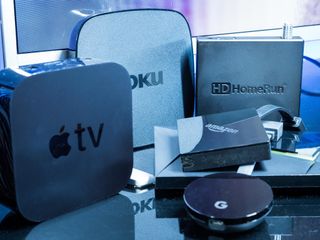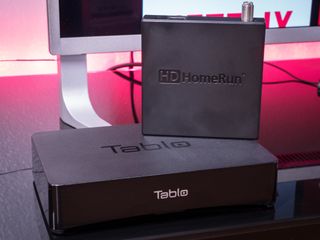The CordCutters guide to hardware
This is what you'll need to do the deed

So you've decided to cut the cord. To get rid of cable TV, anyway. The only real question is how?
It's daunting, we know. Will you be able to watch the same stuff before? How easy will it be? How much will it cost?
WHERE THE HECK DO YOU START?
You start right here, of course, with our complete guide to cutting the cord. That's your top-down view of everything you need to know.
This? This is hardware. Because you'll probably need a little hardware. Or not. Here's the big picture:
The internet itself is key
Getting rid of cable TV means you'll probably be doing a lot of viewing over the internet. Yeah, the same internet that feeds you endless emails and cat GIFs also can be your new provider for all kinds of live TV. But that means a couple things:
If you're going to stream video over the internet all day, you'll need a good internet connection.
First, you need to have a relatively decent internet connection. That'll vary depending on where you live, of course. You don't necessarily need to pony up for a Gigabit connection. Or maybe something that fast isn't even available where you live. While speed is crucial, a simple 10 Mbps connection probably will suffice. Maybe even a tad slower — but we wouldn't go below 5Mbps if at all possible. Video needs a lot of data, especially when you start talking about super high-resolution streams. So faster is always better. (It's also often more expensive, though, especially when you have so many internet service providers with data caps.)
Get the What to Watch Newsletter
The latest updates, reviews and unmissable series to watch and more!
If you've got any questions on that, it's best to hit up your ISP.
Networking speed — that is how fast the data can get from your router to whatever it is you'll be watching the video on — also is important. If you're doing things 100 percent wirelessly, you'll want at least an 802.11n connection.
But better yet — if you're going to be using a streaming box like an Apple TV or NVIDIA Shield TV or some sort of smart TV set, it's even better to run some Ethernet cable straight into your router. It's faster, has less latency (erm, that's also faster), and basically is less prone to any sort of wonk than Wifi.
What about the TV itself? Do you need a new display?
Do you need a new TV if you're going to move to an all-streaming solution? Not necessarily. There's a pretty good chance your current set will still work just fine. So long as it's got at least a single HDMI port (more is always better, though), you'll be OK.
If your TV is relatively new, you're probably OK. But you'll at least want something that's 1080p.
High-definition is also a thing these days. If your set is anything less than 720p (that's the number of horizontal rows of the tiny little lights that make up a display), then it's probably time to upgrade. And while 720p is the bare minimum of what we'd recommend these days, 1080p is the more realistic answer.
What about 4K? That's the "UHD" you'll see on the box, and it means even more pixels packed into a screen. If you're not too worried about price, we say go ahead and get something that does 4K. It'll help future-proof things for later, even if a lot of the streaming you'll be doing today doesn't actually come in at that high a resolution.
And finally there's HDR. We're really starting to get into the nerd weeds here. But the basic version, if you're looking for a new set, is this: HDR10 is fine, Dolby Vision is better.
What streaming box do you need?
This is where the choices really start to get hard. There are a lot of good choices when it comes to the hardware you'll need for streaming TV. If you're serious about your tech, we recommend trying to keep things within the same ecosystem, if possible. Android TV for Android folks, Apple TV for Apple folks.
But that's not necessarily a hard and fast rule. It's also absolutely possible for someone with an Android phone to use an Apple TV and be perfectly fine with it. Here's the short, short version of the major hardware choices:
- Amazon Fire TV: Think of this as Amazon's version of Roku, only more modern in terms of apps and such. For one, it's tied directly to Amazon's stable of content. And it also has Amazon's Alexa voice service built in, which makes using it extremely easy.
- Apple TV: Has apps for all of the major streaming services. It's fast, has a lot of apps for other things like games and smart-home stuff, and Apple keeps the software up to date. Siri is on board, so you can use your voice for all the things.
- Android TV: The NVIDIA Shield TV is the only external Android TV box we recommend, but it's also fairly common to find a TV itself that runs Android TV as its operating system. It's got a world of apps for nearly every major streaming service, plus games and smart-home stuff, too, with Google Assistant built in. Chromecast: This is Google's low-cost dongle for streaming content. You'll control it with your phone, but it'll do all the heavy lifting. And it works on a load of services and apps, whether you use Android or have an iPhone.
- Roku: A longstanding cord-cutting option that brings together all sorts of services in a relatively low-cost piece of hardware. Also has a stable of apps and games. Generally isn't as fast as Android TV or Apple TV. Also can be built in to a TV's operating system.
- PlayStation: Have a PS3 or PS4? You've got some great cord-cutting options, including Sony's own PlayStation Vue. And there are other options, as well.
- Xbox: The Xbox One series also is an excellent option for streaming video — and you can tie over-the-air content into it as well.
More: Our pick for the best streaming box you can buy

Free TV over the air
That's right — antennas are still a thing. While streaming services are getting better about including local channels, it's not always with the best quality. So just like from before cable TV was available, you can still get a world of television over the air. And because we live in some plane of the future, you can even get it in 1080i resolution.
Over-the-air antennas are the best way to get your local channels, and network-level sports.
In a lot of instances — particularly live sports — this might end up looking better than if you were watching it over a streamed video channel. Plus, yeah. It's free.
So don't discount OTA TV — it's definitely worth investing a little money in. The question is what you're going to run it into. You can go straight into a TV set, which is fine. But it's 2018, and we can do better. Boxes like HDHomerun and Tablo take that signal from the antenna and fire it out over your network, so you can watch on multiple devices.
More: The cord-cutter's guide to free OTV television
Also: The best over-the-air antennas
What about DVR and local storage?
A number of streaming services have cloud DVR available. That is, recordings are "kept" in the cloud and streamed to you when you want them. It can get a little messy because content providers still want to show you ads, so sometimes you end up with more of a video-on-demand thing than a true DVR. But you get the idea.
But there also are options for local recordings (particularly for over-the-air content), and often these can double as local media solutions if you have a stockpile of digital movies at the ready. The aforementioned Tablo does it very easily, and there are other options, too.
What else do you need?
You don't necessarily need to go much further than a TV and streaming box and a good internet connection. (And we really do recommend a decent OTA antenna setup.
But you'll also be able to get some good use out of a good universal remote control to help tie everything together. And how about some nice surround sound speakers or a soundbar? And maybe some ambient lighting ... and ...
OK. You can go as simple or as complex as you want. But in any case, get ready to save some money in the long run.
